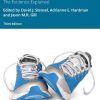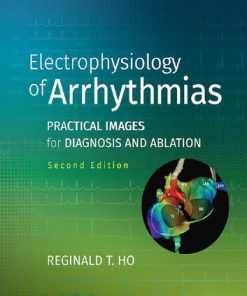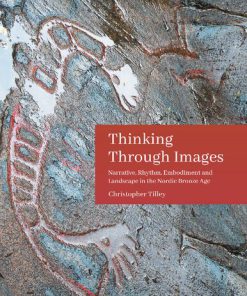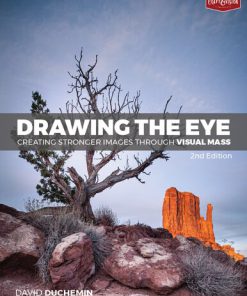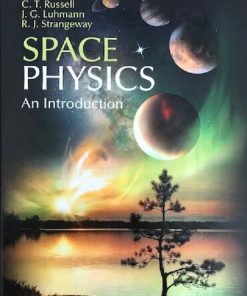The Physics of Clinical MR Taught Through Images 5th Edition by Johannes Heverhagen, Val Runge ISBN 9783030854133 3030854132
$50.00 Original price was: $50.00.$25.00Current price is: $25.00.
The Physics of Clinical MR Taught Through Images 5th Edition by Johannes Heverhagen, Val Runge – Ebook PDF Instant Download/Delivery: 9783030854133 ,3030854132
Full download The Physics of Clinical MR Taught Through Images 5th Edition after payment
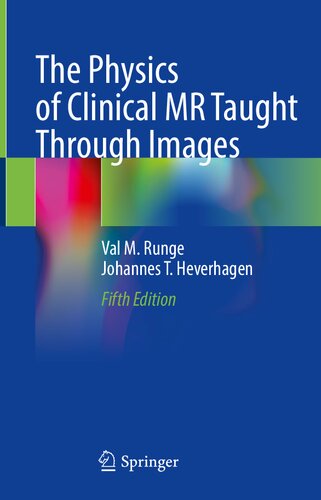
Product details:
ISBN 10: 3030854132
ISBN 13: 9783030854133
Author: Johannes Heverhagen, Val Runge
The Physics of Clinical MR Taught Through Images 5th Edition Table of contents:
Section I: Hardware
1: Components of an MR Scanner
◆ The Magnet
◆ The Transmitting Radiofrequency Coil
◆ The Gradients
◆ The Receiver Coils
2: MR Safety: Static Magnetic Field
3: MR Safety: Gradient Magnetic and Radio-frequency Fields
4: Radio-Frequency Coils
◆ Linearly Polarized Coils
◆ Circularly Polarized Coils
◆ Transmit and Receive Coils
◆ Phased Array (Matrix) Coils
5: Multichannel Coil Technology: Part 1
6: Multichannel Coil Technology: Part 2
7: Open MR Systems
8: Magnetic Field Effects at 3 T and Beyond
9: Mid-Field, High-Field, Ultra-High-Field (1.5, 3, 7 T)
10: Advanced Receiver Coil Design
11: Advanced Multidimensional RF Transmission Design
Section II: Basic Imaging Physics
12: Imaging Basics: k-space, Raw Data, Image Data
13: Image Resolution: Pixel and Voxel Size
14: Imaging Basics: Signal-to-Noise Ratio
15: Imaging Basics: Contrast-to-Noise Ratio
16: Signal-to-Noise Ratio Versus Contrast-to-Noise Ratio
17: Signal-to-Noise Ratio in Clinical 3 T
◆ Field Strength
◆ Chemical Shift
◆ Through-Plane Resolution
18: Slice Orientation
19: Multislice Imaging and Concatenations
20: Number of Averages
21: Slice Thickness
22: Slice Profile
23: Slice Excitation Order (in Fast Spin Echo Imaging)
24: Field of View (Overview)
25: Field of View (Phase Encoding Direction)
26: Matrix Size: Readout
27: Matrix Size: Phase Encoding
28: Partial Fourier
29: Image Interpolation (Zero Filling)
30: Specific Absorption Rate
Section III: Basic Image Acquisition
31: T1, T2, and Proton Density
32: Calculating T1 and T2 Relaxation Times (Calculated Images)
33: Spin Echo Imaging
34: Fast Spin Echo Imaging
35: Fast Spin Echo: Reduced Refocusing Angle
36: Driven-Equilibrium Fourier Transformation (DEFT)
37: Reordering: Phase Encoding
38: Magnetization Transfer
39: Half Acquisition Single-Shot Turbo Spin Echo (HASTE)
40: Spoiled Gradient Echo
41: Refocused (Steady-State) Gradient Echo
42: Echo Planar Imaging
43: Inversion Recovery: Part 1
44: Inversion Recovery: Part 2
45: Fluid-Attenuated IR With Fat Saturation (FLAIR FS)
46: Fat Suppression: Spectral Saturation
47: Water Excitation, Fat Excitation
48: Fat Suppression: Short Tau Inversion Recovery (STIR)
49: Fat Suppression: Phase Cycling
50: Fat Suppression: Dixon
51: 3D Imaging: Basic Principles
52: Contrast Media: Gadolinium Chelates with Extracellular Distribution
53: New High-Relaxivity Gd Chelates
54: Contrast Media: Other Approaches
Section IV: Advanced Image Acquisition
55: Dual-Echo Steady State (DESS)
56: Balanced Gradient Echo: Part 1
57: Balanced Gradient Echo: Part 2
58: PSIF: The Backward-Running FISP
59: Constructive Interference in a Steady State (CISS)
60: TurboFLASH
61: PETRA (UTE)
62: 3D Imaging: MP-RAGE
63: 3D Imaging: SPACE
64: Susceptibility-Weighted Imaging
65: Volume Interpolated Breath-Hold Examination (VIBE)
66: Diffusion-Weighted Imaging
67: Multishot EPI
68: Diffusion Tensor Imaging
69: Blood Oxygen Level-Dependent (BOLD) Imaging: Theory
70: Blood Oxygen Level-Dependent (BOLD) Imaging: Applications
71: Proton Spectroscopy (Theory)
72: Proton Spectroscopy (Chemical Shift Imaging)
73: Simultaneous Multislice
Section V: Flow
74: Flow Effects: Fast and Slow Flow
75: Phase Imaging: Flow
76: 2D Time-of-Flight MRA
77: 3D Time-of-Flight MRA
78: Flip Angle, TR, MT, and Field Strength (in 3D TOF MRA)
79: Phase Contrast MRA
80: 4D Flow MRI
81: Advanced Non-Contrast MRA Techniques
82: Contrast-Enhanced MRA: Basics; Renal, Abdomen
83: Contrast-Enhanced MRA: Carotid Arteries
84: Contrast-Enhanced MRA: Peripheral Circulation
85: Dynamic CE-MRA (TWIST)
86: Dynamic Susceptibility Perfusion Imaging
87: Arterial Spin Labeling
Section VI: Tissue-Specific Techniques
88: Brain Segmentation, Quantitative MR Imaging
89: Cardiac Morphology
90: Cardiac Function
91: Cardiac Imaging: Myocardial Perfusion
92: Cardiac Imaging: Myocardial Viability
93: T1/T2/T2* Quantitative Parametric Mapping in the Heart
94: MR Mammography: Dynamic Imaging
95: MR Mammography: Silicone
96: Hepatic Fat Quantification
97: Hepatic Iron Quantification
98: Elastography
99: Magnetic Resonance Cholangiopancreatography (MRCP)
100: Cartilage Mapping
Section VII: Artifacts, Including Those Due to Motion, and the Reduction Thereof
101: Aliasing
102: Truncation Artifacts
103: Motion: Ghosting and Smearing
104: Motion Reduction: Triggering, Gating, Navigator Echoes
◆ Cardiac Triggering
◆ Respiratory Gating
◆ Navigator Echoes
105: Abdomen: Motion Correction
106: BLADE (PROPELLER)
107: TWIST VIBE
108: Radial VIBE (StarVIBE)
109: GRASP
110: Filtering Images (To Reduce Artifacts)
111: Geometric Distortion
112: Chemical Shift: Sampling Bandwidth
113: Artifacts: Magnetic Susceptibility
114: Maximizing Magnetic Susceptibility
115: Artifacts: Metal
116: Minimizing Metal Artifacts
117: Gradient Moment Nulling
118: Spatial Saturation
119: Shaped Saturation
120: Advanced Slice/Sub-volume Shimming
121: Flow Artifacts
Section VIII: Further Improving Diagnostic Quality, Technologic Innovation
122: Faster and Stronger Gradients: Part 1
123: Faster and Stronger Gradients: Part 2
124: Faster and Stronger Gradients: Part 3
125: Image Composing
126: Filtering Images (To Improve SNR)
127: Parallel Imaging: Part 1
128: Parallel Imaging: Part 2
129: CAIPIRINHA
130: Zoomed EPI
131: Compressed Sensing
132: Cardiovascular Imaging: Compressed Sensing
133: Interventional MR
134: 7 T Brain
135: 7 T Knee
136: Continuous Moving Table
137: Integrated Whole-Body MR-PET
138: 3D Evaluation: Image Post-processing
◆ Multiplanar Reconstruction (MPR)
◆ Maximum Intensity Projection (MIP)
◆ Surface Rendering
◆ Volume Rendering
139: Automatic Image Alignment
140: Workflow Optimization
◆ Imaging Order and Patient Scheduling
◆ Patient and Scan Preparation
◆ Image Acquisition
◆ Post-processing
Section IX: Recent Innovations
141: MR Fingerprinting
142: Simultaneous Multislice (SMS): An Update
143: Compressed Sensing: An Update
144: Advanced Low-Field MR: Part 1—Introduction
145: Advanced Low-Field MR: Part 2—Hardware
◆ Magnet and Receiver Coil Technology
◆ Gradient Performance
146: Advanced Low-Field MR: Part 3—Specific Subtopics
◆ Image Contrast
◆ Simultaneous Multislice
◆ Imaging in High-Susceptibility Regions
◆ Acoustic Noise
◆ Interventional MR
147: Spiral Imaging
148: Respiratory Sensing: An Update
149: GRASP: An Update
150: Deep Learning: For Imaging Reconstruction
151: Monitoring Cardiac Contraction: The Pilot Tone
152: Advocating Low-Field Imaging
153: The Clinical Strengths of 1.5 T
154: The Clinical Strengths of 3 T
155: The Clinical Strengths of 7 T
156: Low Field: Increasing Clinical Access and Further Dissemination of Healthcare
157: 1.5 T: Imaging with Metal
158: 3 T: Focused Musculoskeletal Imaging
159: 1.5 T vs. 3 T for Cardiac Imaging
160: 7 T and the Evaluation of Multiple Sclerosis
Acronyms
Index
People also search for The Physics of Clinical MR Taught Through Images 5th Edition:
lecture on medical physics
physics mri taught through images
physics professor ___ discovered x-rays in 1895
mri physics lecture
introduction to clinical mri physics (part 1 of 3)
Tags:
Johannes Heverhagen,Val Runge,Physics,Clinical MR,Images
You may also like…
Physics - General Courses
Physics 5th Edition by James Walker ISBN 0321976444 9780321976444
History - Archaeology
Arts - Photography
Drawing The Eye Creating Stronger Images Through Visual Mass 2nd Edition David Duchemin
Biography & Autobiography - Political
Through the Broken Glass An Autobiography 1st Edition by TN Seshan ISBN 9357021965 9789357021968
Biology and other natural sciences - Human Biology
The Biological Basis of Clinical Observations, 4th Edition William T. Blows

